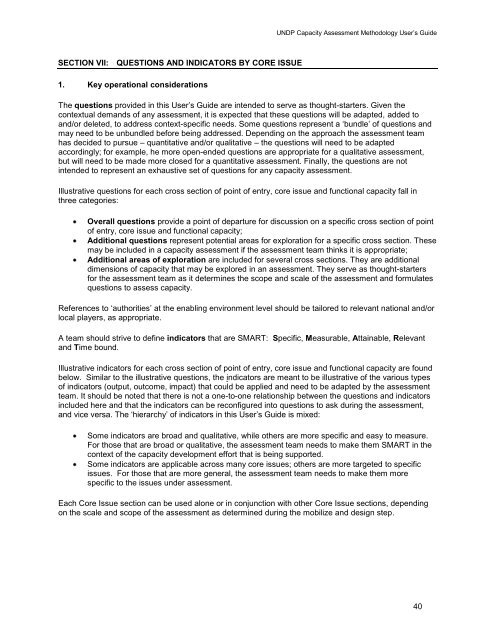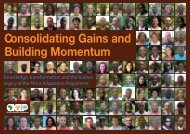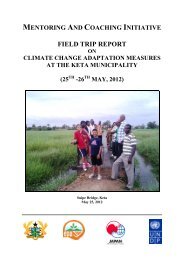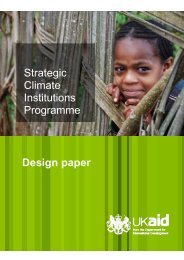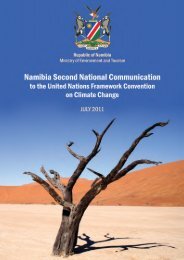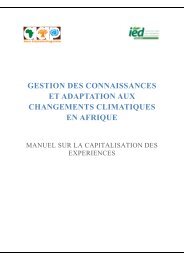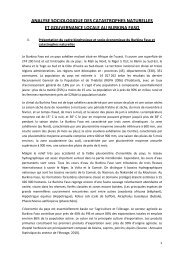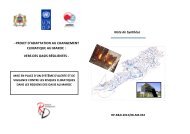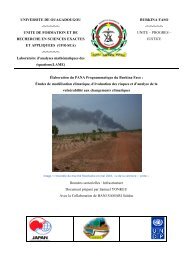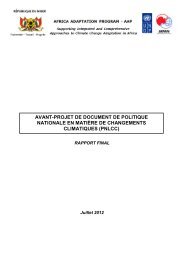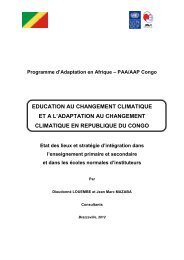UNDP Capacity Assessment Users Guide.pdf - Africa Adaptation ...
UNDP Capacity Assessment Users Guide.pdf - Africa Adaptation ...
UNDP Capacity Assessment Users Guide.pdf - Africa Adaptation ...
Create successful ePaper yourself
Turn your PDF publications into a flip-book with our unique Google optimized e-Paper software.
<strong>UNDP</strong> <strong>Capacity</strong> <strong>Assessment</strong> Methodology User‘s <strong>Guide</strong>SECTION VII: QUESTIONS AND INDICATORS BY CORE ISSUE1. Key operational considerationsThe questions provided in this User‘s <strong>Guide</strong> are intended to serve as thought-starters. Given thecontextual demands of any assessment, it is expected that these questions will be adapted, added toand/or deleted, to address context-specific needs. Some questions represent a ‗bundle‘ of questions andmay need to be unbundled before being addressed. Depending on the approach the assessment teamhas decided to pursue – quantitative and/or qualitative – the questions will need to be adaptedaccordingly; for example, he more open-ended questions are appropriate for a qualitative assessment,but will need to be made more closed for a quantitative assessment. Finally, the questions are notintended to represent an exhaustive set of questions for any capacity assessment.Illustrative questions for each cross section of point of entry, core issue and functional capacity fall inthree categories:Overall questions provide a point of departure for discussion on a specific cross section of pointof entry, core issue and functional capacity;Additional questions represent potential areas for exploration for a specific cross section. Thesemay be included in a capacity assessment if the assessment team thinks it is appropriate;Additional areas of exploration are included for several cross sections. They are additionaldimensions of capacity that may be explored in an assessment. They serve as thought-startersfor the assessment team as it determines the scope and scale of the assessment and formulatesquestions to assess capacity.References to ‗authorities‘ at the enabling environment level should be tailored to relevant national and/orlocal players, as appropriate.A team should strive to define indicators that are SMART: Specific, Measurable, Attainable, Relevantand Time bound.Illustrative indicators for each cross section of point of entry, core issue and functional capacity are foundbelow. Similar to the illustrative questions, the indicators are meant to be illustrative of the various typesof indicators (output, outcome, impact) that could be applied and need to be adapted by the assessmentteam. It should be noted that there is not a one-to-one relationship between the questions and indicatorsincluded here and that the indicators can be reconfigured into questions to ask during the assessment,and vice versa. The ‗hierarchy‘ of indicators in this User‘s <strong>Guide</strong> is mixed:Some indicators are broad and qualitative, while others are more specific and easy to measure.For those that are broad or qualitative, the assessment team needs to make them SMART in thecontext of the capacity development effort that is being supported.Some indicators are applicable across many core issues; others are more targeted to specificissues. For those that are more general, the assessment team needs to make them morespecific to the issues under assessment.Each Core Issue section can be used alone or in conjunction with other Core Issue sections, dependingon the scale and scope of the assessment as determined during the mobilize and design step.40


